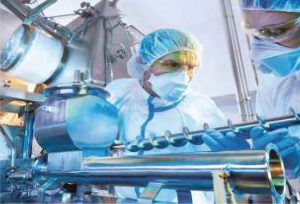“Ten of the world’s top ten pharmaceutical companies and nine of the top ten medtech companies have a signicant presence. We also have a large number of Irish companies that have grown up in the shelter of the global industry. People who started out working for multinationals have gone on to found their own companies, which have become an integral part of the supply chain for global industry. More and more of those companies are developing their own intellectual property and innovative new products,” says Kelly

Ireland is an island in the North Atlantic Ocean, in north-western Europe. It is separated from Great Britain to its east by the North Channel, the Irish Sea and St George’s Channel. Ireland is the second largest island of the British Isles, the third largest in Europe, and the twentieth largest on Earth.
Geopolitically, Ireland is divided between the Republic of Ireland (officially named Ireland), which covers ve-sixths of the island, and Northern Ireland, which is part of the United Kingdom. As of 2022, the population of the entire island is just over 7 million, with 5.1 million living in the Republic of Ireland and 1.9 million in Northern Ireland, ranking it the second most populous island in Europe after Great Britain.
The geography of Ireland comprises relatively low-lying mountains surrounding a central plain, with several navigable rivers extending inland. Its lush vegetation is a product of its mild but changeable climate which is free of extremes in temperature. Much of Ireland was woodland until the end of the Middle Ages. Today, woodland makes up about 10% of the island, compared with a European average of over 33%, with most of it being non-native conifer plantations. The Irish climate is influenced by the Atlantic Ocean and thus very moderate, and winters are milder than expected for such a northerly area, although summers are cooler than those in continental Europe. Rainfall and cloud cover are abundant.
Irish healthcare sector
Ireland has a dual healthcare system, consisting of both private and public healthcare options. The public healthcare system is regulated by the Irish government’s Health Service Executive (HSE). Ireland’s health budget for 2021 was €21 billion. This represents an increase of €4 billion on 2020 levels for health services to continue the ongoing COVID-19 action plan and increase long-term capacity. Budget 2021 provides for the continuation of the extraordinary public health measures and health and social care service supports and capacity introduced in 2020 and aims to build positive permanent change into Irish health service.
Before the global health pandemic, public hospitals were working near full capacity with extensive waiting lists. With the onset of the pandemic, there were particular concerns around the low number of ICU beds available. In December 2020, the Minister for Health announced a strategic multi-year plan to expand adult critical care capacity from 255 beds to 446 beds.
In 2017, a parliamentary Committee on the Future of Healthcare published the Sláintecare Report which outlines a ten-year roadmap to deliver a complete reform of Ireland’s healthcare system to include a universal single-tier health, universal fee GP care and social care system by 2028. The HSE National Service Plan 2021 sets out the type and volume of health and personal social services to be provided in 2021 with the focus of maximizing the delivery of high-quality health and social care services in a new COVID-19 environment.
Irish MedTech sector
The Irish medtech sector has grown from a small group of just 50 companies in the early 1990s to become one of the industry’s leading global hubs with a cluster of 350 companies employing 38,000 people. This makes Ireland the largest employer of medtech professionals in Europe per capita. Ireland is also the second largest exporter of medtech products in Europe, with annual exports of €12.6 billion to over 100 countries globally.
According to Enterprise Ireland Divisional Manager Tom Kelly, the emergence of this vibrant and highly successful indigenous sector is due to a number of factors, including a deep commitment to innovation and the existence of a highly connected ecosystem comprising the world’s leading multinational medtech companies, a first-class academic research sector, and a network of world- leading State-funded research centers.
“Ireland is very much at the forefront of global medtech and life sciences industries,” says Kelly.
“Ten of the world’s top ten pharmaceutical companies and nine of the top ten medtech companies have a significant presence. We also have a large number of Irish companies that have grown up in the shelter of the global industry. People who started out working for multinationals have gone on to found their own companies, which have become an integral part of the supply chain for global industry. More and more of those companies are developing their own intellectual property and innovative new products.”
Support for connections with clinicians and the healthcare sector also plays a key role. Health Innovation Hub Ireland (HIHI) was established to drive collaboration between the health service and enterprise. It offers companies the opportunity to carry out pilot and clinical validation studies, and it offers the health service access to innovative products, services and devices that it may not otherwise be exposed to.
BioInnovate Ireland is a national medical technology innovation training program in which academia, clinicians and industry can collaborate to develop novel medical technologies. The program is a partnership between several universities and hospitals throughout the country and is supported by Enterprise Ireland, the national export agency, and a large number of industry sponsors.
“These linkages between enterprise and the clinical community are very important,” says Kelly. “At Enterprise Ireland we also lead visits of Irish medtech firms to internationally renowned centers such as the Cleveland Clinic and the Mayo Clinic. This aids Irish companies’ awareness of the international demand for new technologies. Our team based in our international offices is also in regular contact with health systems worldwide and provides knowledge and information on their needs to the industry here.”
Ireland’s small size works
Interestingly, Ireland’s small size works in its favor when it comes to the development of a global medtech hub. “Because we are small there is huge interaction between the multinational and indigenous sectors of the industry,” says Kelly. “This is a signicant advantage. The highly connected nature of the industry allows relatively small Irish firms achieve global success quite quickly.”
Irish firms are increasingly becoming integral elements of the global medtech supply chains. “Irish medtech companies are not only becoming suppliers of choice to multinational customers here in Ireland but they are doing so globally as well,” says Kelly. “That applies to companies supplying services as well as components. Our approach is to encourage companies to become not just sub-suppliers but become co-developers and value adders. Enterprise Ireland can provide R&D support to companies that collaborate with customers in this way.”
One of most important initiatives in this area is the €500 million Disruptive Technology Innovation Fund. “This offers an opportunity for SME-type companies to collaborate with multinationals and research centers to develop new products a n d technologies which in turn will help them create even deeper relationships with partners.”
The critical ingredient in the global success of the indigenous Irish medtech sec tor is innovation, according to Kelly. “Irish medtech companies are very much committed to innovation. This is not just a case of continuous improvement. They have to constantly innovate if they are to meet unmet clinical needs. The market is continually evolving and only companies that can supply the new products, technologies and services to meet the changing needs of medical practice will succeed. They also have to be committed to investing in growth and scale as well as the capability of their people. That’s how the Irish medtech industry is succeeding and will continue to succeed.”




Opportunities
By 2040, the population of Ireland is expected to reach 5.7 million people with population health forecast to have decreasing mortality rates and longer life expectancies. This rapidly growing and ageing population will create an exponential demand for increased healthcare services with a focus on acute hospitals, primary care and geriatric services. In addition, the global health pandemic has highlighted the importance of developing and adopting digital solutions. This has resulted in an acceleration in digitalization across the Irish healthcare sector and a rise in the adoption of digital health technologies.
The digital response to the pandemic, particularly for clinical management (rapid diagnosis and risk prediction), has been a significantly successful undertaking across the health services sector. Innovative digital health solutions in healthcare will continue to be required and are expected to be an essential part of the future Irish health landscape. Whilst Ireland’s investment in Digital Health is lower than most other EU countries, funding has increased 25 percent to €120m in 2021. The eHealth and ICT Capital Plan includes further detail on all eHealth and health information systems developments for 2021 and beyond.
Additional capital investment projects and programs along with significant reform initiatives are planned for the health sector as outlined in the Ireland National Development Plan 2018-2027. These include the construction of new hospitals and additional capacity to existing facilities in areas such as maternity, oncology, mental health, primary and residential care, nursing homes, acute care, rehabilitation and disability. The government will publish a revised National Development Plan in October 2021. US Commercial Service Ireland will monitor this plan for new opportunities for American exporters and service providers across the Irish healthcare sector.
Opportunities exist for medical equipment that save time and resources while also effecting cost savings in this price sensitive market. A new trend is emerging with increased demand for high quality American-made products to counteract cheaper less reliable imports from other nations. Ireland is also an advocate of preventative medicine focusing on breast, cervical, bowel and diabetic retina screening/checks and opportunities exist for a wide range of equipment across these healthcare disciplines.
All public sector contracting authorities advertise procurement opportunities and award notices on the eTenders Procurement website, the Irish Government’s electronic tendering platform. Interested US suppliers should register as a Supplier Company especially as electronic tendering will be a European requirement in the next few years.
















